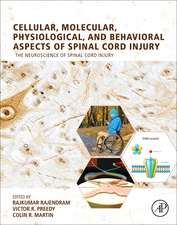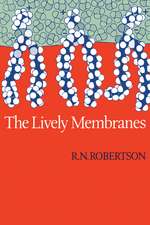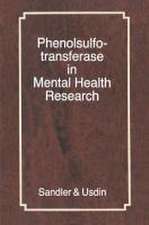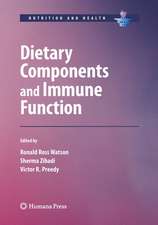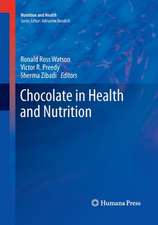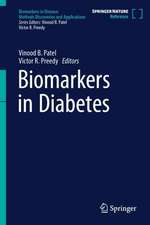Nutrition and Neurological Disorders
Editat de Colin R Martin, Vinood B. Patel, Victor R. Preedyen Limba Engleză Hardback – 26 aug 2023
This volume provides a platform for research on vitamins and minerals and on future investigations of these compounds.
- Summarizes diet and nutrition research for a variety of neurological conditions
- Contains chapter abstracts, key facts, dictionary of terms, summary points and applications to other areas of neurological conditions
- Covers diet in Alzheimer’s, Parkinson’s, ALS, and MS, among others
- Includes conditions such as migraine, headache, stroke, and brain injury
- Discusses the Mediterranean diet in the context of brain health
Preț: 2890.56 lei
Preț vechi: 3559.22 lei
-19% Nou
Puncte Express: 4336
Preț estimativ în valută:
553.18€ • 575.39$ • 456.68£
553.18€ • 575.39$ • 456.68£
Carte disponibilă
Livrare economică 15-29 martie
Livrare express 11-15 martie pentru 807.71 lei
Preluare comenzi: 021 569.72.76
Specificații
ISBN-13: 9780443186240
ISBN-10: 0443186243
Pagini: 700
Ilustrații: Approx. 125 illustrations (125 in full color)
Dimensiuni: 191 x 235 x 238 mm
Greutate: 7.24 kg
Editura: ELSEVIER SCIENCE
ISBN-10: 0443186243
Pagini: 700
Ilustrații: Approx. 125 illustrations (125 in full color)
Dimensiuni: 191 x 235 x 238 mm
Greutate: 7.24 kg
Editura: ELSEVIER SCIENCE
Cuprins
Diet and Nutrition in Neurological Disorders: 1. Neurological disorders in the context of the global burden of disease
Part I - Alzheimer’s disease and dementias2. Lifestyle modifications and nutrition in Alzheimer’s disease; 3. The Gut microbiota and Alzheimer’s disease; 4. The Mediterranean diet: Unsaturated fatty acids and prevention of Alzheimer’s disease; 5. Malnutrition and early-stage Alzheimer’s disease
Part II - Amyotrophic lateral sclerosis6. Hydration in amyotrophic lateral sclerosis; 7. Diet, disease severity, and energy expenditure in amyotrophic lateral sclerosis (ALS); 8. Nutrition, percutaneous endoscopic gastrostomy and ALS; 9. Fatty acid profiling in amyotrophic lateral sclerosis
Part III - Brain injury10. High-fat diets in traumatic brain injury: A ketogenic diet resolves what the western diet messes up: Neuroinflammation and beyond; 11. Brain injury, anthropometry, and nutrition; 12. Calorie and protein intake in traumatic brain injury patients; 13. Lipids, docosahexaenoic acid (DHA), and traumatic brain injury; 14. Brain trauma, ketogenic diets, ketogenesis, and via enteral nutrition
Part IV - Cerebral palsy15. Nutrition and cerebral palsy; 16. Metabolic syndrome in adult cerebral palsy: Implications for diet; 17. Gut microbiota characteristics in children with cerebral palsy; 18. Swallowing problems: Major components of nutritional deficits in adults with cerebral palsy
Part V - Dietary neurotoxins19. Dietary neurotoxins: An overview; 20. Alcohol consumption induces oxidative damage, neuronal injury, and synaptic impairment: Consequences for our brain health; 21. Dietary effects of lead as a neurotoxicant; 22. Environmental toxicants (OPs and heavy metals) in the diet: What are their repercussions on behavioral/neurological systems?
Part VI – Epilepsy23. Hypercholesterolemic diet and status epilepticus; 24. Low glycemic index therapy: What it is and how it compares to other epilepsy diets; 25. Ketogenic diet in pediatric epilepsies
Part VII - Headaches and migraines26. The value of fruit and vegetable consumption in pediatric migraine; 27. Dietary trigger factors of migraine
Part VIII - Multiple sclerosis28. Diet and nutrition in multiple sclerosis management; 29. Dietary fish intake and multiple sclerosis: A new narrative; 30. Linking diet, gut microbiota, and multiple sclerosis; 31. Restoration of myelination in the central nervous system via specific dietary bioactive lipids: An opportunity to halt disease progression in multiple sclerosis
Part IX - Neuroinflammation32. Effect of diet and nutrition on neuroinflammation: An overview; 33. High-fat diet-induced cellular neuroinflammation: Alteration of brain functions and associated aliments; 34. Neural implications of a high-fructose diet
Part X - Parkinson’s disease35. Role of mediterranean diet in Parkinson’s disease; 36. Role of dietary antioxidants and redox status in Parkinson’s disease; 37. Beverages, caffeine, and Parkinson’s disease; 38. The association of diet and its components with changes in gut microbiota and improvement in Parkinson’s disease
Part XI - Peripheral neuropathy39. Alcohol-related autonomic dysfunction and peripheral neuropathy 40. Dietary saturated and unsaturated fatty acids and peripheral neuropathy41. Caloric restriction as a nutrition strategy in counteracting peripheral neuropathies
Part XII - Prenatal effects and neurodevelopment42. The interplay between stress and nutrition during pregnancy: Influence on fetal brain development 43. Maternal and neonatal polyunsaturated fatty acid intake and risk of neurodevelopmental impairment in premature infants44. Early nutrition, growth, and neurodevelopment in the preterm infant 45. Breast milk and cognitive performance in children 46. Effects of ketogenic diets and ketone supplementation on the nervous system during development: Applications to autism spectrum disorders and schizophrenia
Part XIII - Stroke47. Fluids, energy intake, and stroke; 48. Cachexia after stroke; 49. Linking stroke and dietary pattern: An Indian perspective; 50. Dietary lipids: The effect of docosahexaenoic acid on stroke-related neuronal damage; 51. Diet quality and stroke; 52. Recommended resources for diet and nutrition in neurological disorders
Vitamins and Minerals in Neurological Disorders: 1. Vitamins and minerals in the context of reference values and requirements
Part I - Alzheimer’s disease and dementias2. α-Tocopherol for Alzheimer’s disease; 3. Cognitive impairment and micronutrients: Vitamin B12, folate, and homocysteine and implications for dementia; 4. Magnesium and Alzheimer’s disease; 5. Copper, oxidative stress, Alzheimer’s disease, and dementia; 6. Chromium and Alzheimer’s disease
Part II - Amyotrophic lateral sclerosis7. Riboflavin and lower motor neuron diseases
Part III - Brain injury8. Vitamin C (L-ascorbic acid) in brain injury; 9. Antioxidants in brain injury with or without antibiotics; 10. Vitamin D and traumatic brain injury; 11. Zinc and traumatic brain injury
Part IV - Cerebral palsy12. Cerebral palsy: Evaluating vitamin D levels
Part V - Dietary neurotoxins13. Linking copper and neurotoxic activities
Part VI - Epilepsy14. Epilepsy-derived neurodegeneration and vitamin E; 15. Selenium use in epilepsy; 16. Reduced vitamin C and minerals in epilepsy; 17. Thiamine, transporters, and epilepsy
Part VII - Headaches and migraines18. Riboflavin usage in pediatric migraine; 19. Vitamin B12, folate, and migraine; 20. Vitamin D and migraine
Part VIII - Multiple sclerosis21. Iron, zinc, and multiple sclerosis patients; 22. Considerations on vitamin D supplementation in multiple sclerosis
Part IX - Neuroinflammation23. Neuroinflammation: Role of magnesium; 24. Vitamin B12 as a neuroprotectant in neuroinflammation; 25. Vitamin D3 (VD3) effects on neuroinflammation and neurodegenerative disorders: Focus on Alzheimer’s and Parkinson’s diseases; 26. Vitamin C and neuroinflammation; 27. Vitamin A and all-trans retinoic acid (ATRA) on neuroinflammatory changes in the brain; 28. Fluoride excess and neuroinflammation
Part X - Parkinson’s disease29. Vitamin D and Parkinson’s disease; 30. Tocotrienols and Parkinson’s disease: In vitro and in vivo modeling; 31. B vitamins: Pyridoxal phosphate and parkinsonism; 32. Antioxidant vitamins in Parkinson’s disease: Vitamins A, C, E; 33. Role of calcium in Parkinson’s disease; 34. Micronutrient levels in Parkinson’s disease; 35. Genes and dietary metals in Parkinson’s disease
Part XI - Peripheral neuropathy36. Vitamin D levels and diabetic peripheral neuropathy; 37. B vitamins on the nervous system: A focus on peripheral neuropathy
Part XII - Prenatal effects and neurodevelopment38. Dietary B-vitamin deficiencies and maternal oversupplementation on neurodevelopment: An updated narrative; 39. Essential trace elements in neurodevelopment: An updated narrative; 40. Gestational folic acid in neuronal development of the hypothalamus
Part XIII - Stroke41. Vitamin B12, hyperhomocysteinemia, and stroke; 42. Sodium and stroke; 43. Calcium intake and the risk of stroke; 44. Recommended resources for the study and investigation of vitamins and minerals in neurological disorders
Treatments, Nutraceuticals, Supplements and Herbal Medicine in Neurological Disorders: Part I - Alzheimer’s disease and dementias1. Guarana (Paullinia cupana Mart.): Applications to Alzheimer’s disease and dementias; 2. Herbs for Alzheimer’s disease management; clinical studies: A narrative; 3. Reducing neurodegeneration and oxidative damage in Alzheimer’s disease: Role of the Nrf2 pathway activation by natural compounds; 4. Alzheimer’s disease and green coffee bean extract; 5. Callistemon viminalis and protection in Alzheimer’s disease; 6. Herbs for Alzheimer’s disease management—Preclinical studies: A narrative; 7. Allicin as nutraceutical usage in Alzheimer’s disease
Part II - Amyotrophic lateral sclerosis8. Rutin and its application to amyotrophic lateral sclerosis; 9. Kaempferol and kaempferide and amyotrophic lateral sclerosis
Part III - Brain injury10. French maritime pine bark extract and neurological disorders; 11. Angong Niuhuang pill could be an effective medicinal agent for stroke treatment; 12. Polyphenols as therapeutic interventions against cerebral ischemic injury; 13. Chinese herbal medicine in brain injury and other neurological disorders
Part IV - Dietary neurotoxins14. Protection by Coriandrum sativum against mercury neurotoxicity; 15. Taurine in symptom amelioration and recovery in lead induced neurotoxicity; 16. Omega-3 fatty acid as a protectant in lead-induced neurotoxicity
Part V – Epilepsy17. Dietary flavonoids and management of epilepsy; 18. Magnesium supplemental therapy in epileptogenesis and ictogenesis; 19. Curcumin usage in epilepsy; 20. Triheptanoin as a nutraceutical and its potential use in epilepsy
Part VI - Headaches and migraines21. Dietary supplementation in migraine: A focus on omega-3 fatty acids; 22. Headaches, migraine, and herbal medicine; 23. Magnesium and migraine
Part VII - Multiple sclerosis24. Betaine as a neuroprotective therapy in multiple sclerosis; 25. Natural products and their bioactive compounds in multiple sclerosis; 26. The crocin usage in multiple sclerosis
Part VIII – Neuroinflammation27. The potential role of herbal medicine and nutraceutical in neuroinflammatory disorders: A mechanistic insight via multisignaling cascades; 28. Arbutin as a natural soluble glycosylated phenol and usage in neuroinflammation; 29. Plant-based oils used to treat neuroinflammation; 30. Antineuroinflammatory potentials of Clinacanthus nutans leaf; 31. Nutraceuticals and bioactive components of herbal extract in the treatment and prevention of neurological disorders; 32. Effect of Tinospora cordifolia on neuroinflammation; 33. Neuroprotective potential of quercetin as a nutraceutical targeting fused neuroinflammation in neurological disease
Part IX - Parkinson’s disease34. Prebiotics and probiotics and Parkinson’s disease; 35. Omega-3 polyunsaturated fatty acids and its use in Parkinson’s disease; 36. The flavone chrysin and usage in Parkinson’s disease; 37. Blackberry (Morus nigra) usage in Parkinson’s disease
Part X - Peripheral neuropathy38. Use of coumarin osthole in peripheral neuropathy; 39. Therapeutic benefits of phenolic acids in peripheral neuropathy; 40. Resveratrol as a potential therapeutic molecule against neuropathy: A new narrative; 41. Nutrition and neurological disorders; 42. Cleistocalyx nervosum var. paniala fruit on neuropathy
Part XI - Prenatal effects and neurodevelopment43. Nutritional supplementation for the prevention and treatment of neonatal brain injury: Breast milk and beyond; 44. Maternal naringenin supplementation during pregnancy disrupts the redox status in the developing rats’ brain; 45. Tryptophan as a supplement in cerebral palsy; 46. Centella asiatica and protection in neurodevelopment
Part XII – Stroke47. Genistein and its use as a neuroprotective agent in stroke; 48. Leucine-enriched amino acid supplement and use in stroke; 49. Arginine and neuroprotection: A focus on stroke; 50. Isoflavones as nutraceuticals in stroke: Therapeutic targets and signaling pathways; 51. Trigonelline and its uses in stroke
Part XIII - Resources52. Recommended resources for studying nutraceuticals, botanical medicine, and neurological disorders
Part I - Alzheimer’s disease and dementias2. Lifestyle modifications and nutrition in Alzheimer’s disease; 3. The Gut microbiota and Alzheimer’s disease; 4. The Mediterranean diet: Unsaturated fatty acids and prevention of Alzheimer’s disease; 5. Malnutrition and early-stage Alzheimer’s disease
Part II - Amyotrophic lateral sclerosis6. Hydration in amyotrophic lateral sclerosis; 7. Diet, disease severity, and energy expenditure in amyotrophic lateral sclerosis (ALS); 8. Nutrition, percutaneous endoscopic gastrostomy and ALS; 9. Fatty acid profiling in amyotrophic lateral sclerosis
Part III - Brain injury10. High-fat diets in traumatic brain injury: A ketogenic diet resolves what the western diet messes up: Neuroinflammation and beyond; 11. Brain injury, anthropometry, and nutrition; 12. Calorie and protein intake in traumatic brain injury patients; 13. Lipids, docosahexaenoic acid (DHA), and traumatic brain injury; 14. Brain trauma, ketogenic diets, ketogenesis, and via enteral nutrition
Part IV - Cerebral palsy15. Nutrition and cerebral palsy; 16. Metabolic syndrome in adult cerebral palsy: Implications for diet; 17. Gut microbiota characteristics in children with cerebral palsy; 18. Swallowing problems: Major components of nutritional deficits in adults with cerebral palsy
Part V - Dietary neurotoxins19. Dietary neurotoxins: An overview; 20. Alcohol consumption induces oxidative damage, neuronal injury, and synaptic impairment: Consequences for our brain health; 21. Dietary effects of lead as a neurotoxicant; 22. Environmental toxicants (OPs and heavy metals) in the diet: What are their repercussions on behavioral/neurological systems?
Part VI – Epilepsy23. Hypercholesterolemic diet and status epilepticus; 24. Low glycemic index therapy: What it is and how it compares to other epilepsy diets; 25. Ketogenic diet in pediatric epilepsies
Part VII - Headaches and migraines26. The value of fruit and vegetable consumption in pediatric migraine; 27. Dietary trigger factors of migraine
Part VIII - Multiple sclerosis28. Diet and nutrition in multiple sclerosis management; 29. Dietary fish intake and multiple sclerosis: A new narrative; 30. Linking diet, gut microbiota, and multiple sclerosis; 31. Restoration of myelination in the central nervous system via specific dietary bioactive lipids: An opportunity to halt disease progression in multiple sclerosis
Part IX - Neuroinflammation32. Effect of diet and nutrition on neuroinflammation: An overview; 33. High-fat diet-induced cellular neuroinflammation: Alteration of brain functions and associated aliments; 34. Neural implications of a high-fructose diet
Part X - Parkinson’s disease35. Role of mediterranean diet in Parkinson’s disease; 36. Role of dietary antioxidants and redox status in Parkinson’s disease; 37. Beverages, caffeine, and Parkinson’s disease; 38. The association of diet and its components with changes in gut microbiota and improvement in Parkinson’s disease
Part XI - Peripheral neuropathy39. Alcohol-related autonomic dysfunction and peripheral neuropathy 40. Dietary saturated and unsaturated fatty acids and peripheral neuropathy41. Caloric restriction as a nutrition strategy in counteracting peripheral neuropathies
Part XII - Prenatal effects and neurodevelopment42. The interplay between stress and nutrition during pregnancy: Influence on fetal brain development 43. Maternal and neonatal polyunsaturated fatty acid intake and risk of neurodevelopmental impairment in premature infants44. Early nutrition, growth, and neurodevelopment in the preterm infant 45. Breast milk and cognitive performance in children 46. Effects of ketogenic diets and ketone supplementation on the nervous system during development: Applications to autism spectrum disorders and schizophrenia
Part XIII - Stroke47. Fluids, energy intake, and stroke; 48. Cachexia after stroke; 49. Linking stroke and dietary pattern: An Indian perspective; 50. Dietary lipids: The effect of docosahexaenoic acid on stroke-related neuronal damage; 51. Diet quality and stroke; 52. Recommended resources for diet and nutrition in neurological disorders
Vitamins and Minerals in Neurological Disorders: 1. Vitamins and minerals in the context of reference values and requirements
Part I - Alzheimer’s disease and dementias2. α-Tocopherol for Alzheimer’s disease; 3. Cognitive impairment and micronutrients: Vitamin B12, folate, and homocysteine and implications for dementia; 4. Magnesium and Alzheimer’s disease; 5. Copper, oxidative stress, Alzheimer’s disease, and dementia; 6. Chromium and Alzheimer’s disease
Part II - Amyotrophic lateral sclerosis7. Riboflavin and lower motor neuron diseases
Part III - Brain injury8. Vitamin C (L-ascorbic acid) in brain injury; 9. Antioxidants in brain injury with or without antibiotics; 10. Vitamin D and traumatic brain injury; 11. Zinc and traumatic brain injury
Part IV - Cerebral palsy12. Cerebral palsy: Evaluating vitamin D levels
Part V - Dietary neurotoxins13. Linking copper and neurotoxic activities
Part VI - Epilepsy14. Epilepsy-derived neurodegeneration and vitamin E; 15. Selenium use in epilepsy; 16. Reduced vitamin C and minerals in epilepsy; 17. Thiamine, transporters, and epilepsy
Part VII - Headaches and migraines18. Riboflavin usage in pediatric migraine; 19. Vitamin B12, folate, and migraine; 20. Vitamin D and migraine
Part VIII - Multiple sclerosis21. Iron, zinc, and multiple sclerosis patients; 22. Considerations on vitamin D supplementation in multiple sclerosis
Part IX - Neuroinflammation23. Neuroinflammation: Role of magnesium; 24. Vitamin B12 as a neuroprotectant in neuroinflammation; 25. Vitamin D3 (VD3) effects on neuroinflammation and neurodegenerative disorders: Focus on Alzheimer’s and Parkinson’s diseases; 26. Vitamin C and neuroinflammation; 27. Vitamin A and all-trans retinoic acid (ATRA) on neuroinflammatory changes in the brain; 28. Fluoride excess and neuroinflammation
Part X - Parkinson’s disease29. Vitamin D and Parkinson’s disease; 30. Tocotrienols and Parkinson’s disease: In vitro and in vivo modeling; 31. B vitamins: Pyridoxal phosphate and parkinsonism; 32. Antioxidant vitamins in Parkinson’s disease: Vitamins A, C, E; 33. Role of calcium in Parkinson’s disease; 34. Micronutrient levels in Parkinson’s disease; 35. Genes and dietary metals in Parkinson’s disease
Part XI - Peripheral neuropathy36. Vitamin D levels and diabetic peripheral neuropathy; 37. B vitamins on the nervous system: A focus on peripheral neuropathy
Part XII - Prenatal effects and neurodevelopment38. Dietary B-vitamin deficiencies and maternal oversupplementation on neurodevelopment: An updated narrative; 39. Essential trace elements in neurodevelopment: An updated narrative; 40. Gestational folic acid in neuronal development of the hypothalamus
Part XIII - Stroke41. Vitamin B12, hyperhomocysteinemia, and stroke; 42. Sodium and stroke; 43. Calcium intake and the risk of stroke; 44. Recommended resources for the study and investigation of vitamins and minerals in neurological disorders
Treatments, Nutraceuticals, Supplements and Herbal Medicine in Neurological Disorders: Part I - Alzheimer’s disease and dementias1. Guarana (Paullinia cupana Mart.): Applications to Alzheimer’s disease and dementias; 2. Herbs for Alzheimer’s disease management; clinical studies: A narrative; 3. Reducing neurodegeneration and oxidative damage in Alzheimer’s disease: Role of the Nrf2 pathway activation by natural compounds; 4. Alzheimer’s disease and green coffee bean extract; 5. Callistemon viminalis and protection in Alzheimer’s disease; 6. Herbs for Alzheimer’s disease management—Preclinical studies: A narrative; 7. Allicin as nutraceutical usage in Alzheimer’s disease
Part II - Amyotrophic lateral sclerosis8. Rutin and its application to amyotrophic lateral sclerosis; 9. Kaempferol and kaempferide and amyotrophic lateral sclerosis
Part III - Brain injury10. French maritime pine bark extract and neurological disorders; 11. Angong Niuhuang pill could be an effective medicinal agent for stroke treatment; 12. Polyphenols as therapeutic interventions against cerebral ischemic injury; 13. Chinese herbal medicine in brain injury and other neurological disorders
Part IV - Dietary neurotoxins14. Protection by Coriandrum sativum against mercury neurotoxicity; 15. Taurine in symptom amelioration and recovery in lead induced neurotoxicity; 16. Omega-3 fatty acid as a protectant in lead-induced neurotoxicity
Part V – Epilepsy17. Dietary flavonoids and management of epilepsy; 18. Magnesium supplemental therapy in epileptogenesis and ictogenesis; 19. Curcumin usage in epilepsy; 20. Triheptanoin as a nutraceutical and its potential use in epilepsy
Part VI - Headaches and migraines21. Dietary supplementation in migraine: A focus on omega-3 fatty acids; 22. Headaches, migraine, and herbal medicine; 23. Magnesium and migraine
Part VII - Multiple sclerosis24. Betaine as a neuroprotective therapy in multiple sclerosis; 25. Natural products and their bioactive compounds in multiple sclerosis; 26. The crocin usage in multiple sclerosis
Part VIII – Neuroinflammation27. The potential role of herbal medicine and nutraceutical in neuroinflammatory disorders: A mechanistic insight via multisignaling cascades; 28. Arbutin as a natural soluble glycosylated phenol and usage in neuroinflammation; 29. Plant-based oils used to treat neuroinflammation; 30. Antineuroinflammatory potentials of Clinacanthus nutans leaf; 31. Nutraceuticals and bioactive components of herbal extract in the treatment and prevention of neurological disorders; 32. Effect of Tinospora cordifolia on neuroinflammation; 33. Neuroprotective potential of quercetin as a nutraceutical targeting fused neuroinflammation in neurological disease
Part IX - Parkinson’s disease34. Prebiotics and probiotics and Parkinson’s disease; 35. Omega-3 polyunsaturated fatty acids and its use in Parkinson’s disease; 36. The flavone chrysin and usage in Parkinson’s disease; 37. Blackberry (Morus nigra) usage in Parkinson’s disease
Part X - Peripheral neuropathy38. Use of coumarin osthole in peripheral neuropathy; 39. Therapeutic benefits of phenolic acids in peripheral neuropathy; 40. Resveratrol as a potential therapeutic molecule against neuropathy: A new narrative; 41. Nutrition and neurological disorders; 42. Cleistocalyx nervosum var. paniala fruit on neuropathy
Part XI - Prenatal effects and neurodevelopment43. Nutritional supplementation for the prevention and treatment of neonatal brain injury: Breast milk and beyond; 44. Maternal naringenin supplementation during pregnancy disrupts the redox status in the developing rats’ brain; 45. Tryptophan as a supplement in cerebral palsy; 46. Centella asiatica and protection in neurodevelopment
Part XII – Stroke47. Genistein and its use as a neuroprotective agent in stroke; 48. Leucine-enriched amino acid supplement and use in stroke; 49. Arginine and neuroprotection: A focus on stroke; 50. Isoflavones as nutraceuticals in stroke: Therapeutic targets and signaling pathways; 51. Trigonelline and its uses in stroke
Part XIII - Resources52. Recommended resources for studying nutraceuticals, botanical medicine, and neurological disorders

